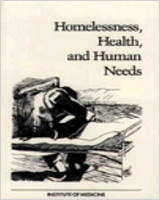NCBI Bookshelf. A service of the National Library of Medicine, National Institutes of Health.
There have always been homeless people in the United States, but their plight has only recently stirred widespread public reaction and concern. Part of this new recognition stems from the problem's prevalence: the number of homeless individuals, while hard to pin down exactly, is rising. In light of this, Congress asked the Institute of Medicine to find out whether existing health care programs were ignoring the homeless or delivering care to them inefficiently. This book is the report prepared by a committee of experts who examined these problems through visits to city slums and impoverished rural areas, and through an analysis of papers written by leading scholars in the field.
Contents
- Committee on Health Care for Homeless People
- Preface
- 1. Who Are the Homeless?
- 2. Dynamics of Homelessness
- 3. Health Problems of Homeless People
- Types of Interactions Between Health and Homelessness
- General Health Problems of Homeless Adults
- Mental Illness, Alcoholism, Drug Abuse, and Comorbidity of Homeless Adults
- Health Problems of Homeless Families, Children, and Youths
- Summary
- Key to Abbreviations and Explanatory Notes for Tables 3-1 to 3-6
- References
- 4. Access to Health Care Services for Homeless People
- 5. Health Care Services for Homeless People
- 6. Summary and Recommendations
- Appendixes
The work on which this publication is based was performed pursuant to Contract No. 240-86-0073 with the Health Resources and Services Administration of the Department of Health and Human Services. Additional support for this study was contributed by the Veterans Administration and the National Research Council (NRC) Fund. The NRC Fund is a pool of private, discretionary, nonfederal funds that is used to support a program of Academy-initiated studies of national issues in which science and technology figure significantly. The NRC Fund consists of contributions from a consortium of private foundations including the Carnegie Corporation of New York, the Charles E. Culpeper Foundation, the William and Flora Hewlett Foundation, the John D. and Catherine T. MacArthur Foundation, the Andrew W. Mellon Foundation, the Rockefeller Foundation, and the Alfred P. Sloan Foundation; the Academy Industry Program, which seeks annual contributions from companies that are concerned with the health of U.S. science and technology and with public policy issues with technology content; and the National Academy of Sciences and the National Academy of Engineering endowments.
NOTICE: The project that is the subject of this report was approved by the Governing Board of the National Research Council, whose members are drawn from the councils of the National Academy of Sciences, the National Academy of Engineering, and the Institute of Medicine. The members of the committee responsible for the report were chosen for their special competences and with regard for appropriate balance.
This report has been reviewed by a group other than the authors according to procedures approved by a Report Review Committee consisting of members of the National Academy of Sciences, the National Academy of Engineering, and the Institute of Medicine.
The Institute of Medicine was chartered in 1970 by the National Academy of Sciences to enlist distinguished members of the appropriate professions in the examination of policy matters pertaining to the health of the public. In this, the Institute acts under both the Academy's 1863 congressional charter responsibility to be an adviser to the federal government and its own initiative in identifying issues of medical care, research, and education.
- NLM CatalogRelated NLM Catalog Entries
- Procedures and methods of benefit assessments for medicines in Germany.[Eur J Health Econ. 2008]Procedures and methods of benefit assessments for medicines in Germany.Bekkering GE, Kleijnen J. Eur J Health Econ. 2008 Nov; 9 Suppl 1:5-29.
- [Procedures and methods of benefit assessments for medicines in Germany].[Dtsch Med Wochenschr. 2008][Procedures and methods of benefit assessments for medicines in Germany].Bekkering GE, Kleijnen J. Dtsch Med Wochenschr. 2008 Dec; 133 Suppl 7:S225-46. Epub 2008 Nov 25.
- Assuring access to dental care for low-income families in North Carolina. The NC Institute of Medicine Task Force Study.[N C Med J. 2000]Assuring access to dental care for low-income families in North Carolina. The NC Institute of Medicine Task Force Study.Silberman P, Wicker DA, Smith SH Jr, DeFriese GH. N C Med J. 2000 Mar-Apr; 61(2):95-8.
- Review Peer support for people with chronic conditions in rural areas: a scoping review.[Rural Remote Health. 2016]Review Peer support for people with chronic conditions in rural areas: a scoping review.Lauckner HM, Hutchinson SL. Rural Remote Health. 2016 Jan-Mar; 16(1):3601. Epub 2016 Mar 5.
- Review Reclaiming the community: the strengths perspective and deinstitutionalization.[Soc Work. 1992]Review Reclaiming the community: the strengths perspective and deinstitutionalization.Sullivan WP. Soc Work. 1992 May; 37(3):204-9.
- Homelessness, Health, and Human NeedsHomelessness, Health, and Human Needs
Your browsing activity is empty.
Activity recording is turned off.
See more...
